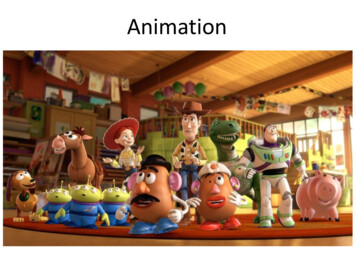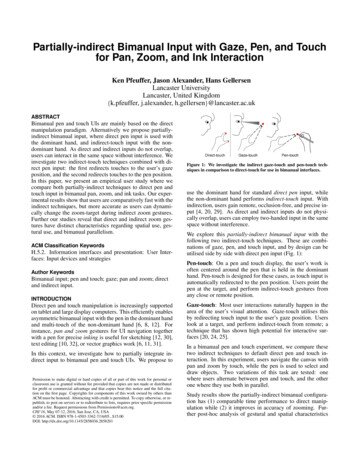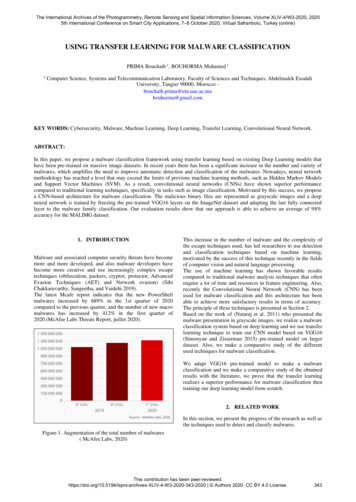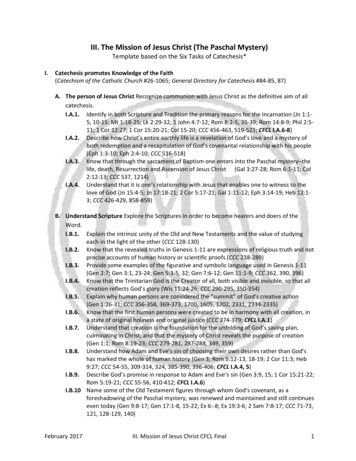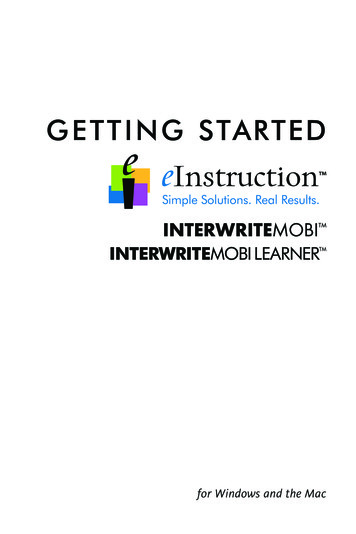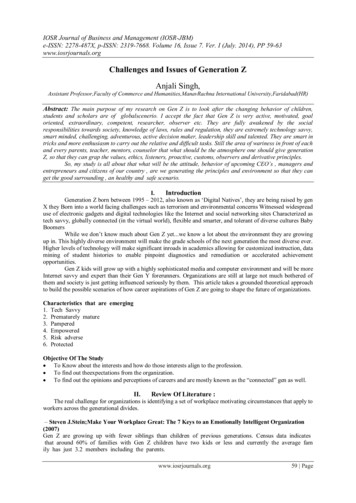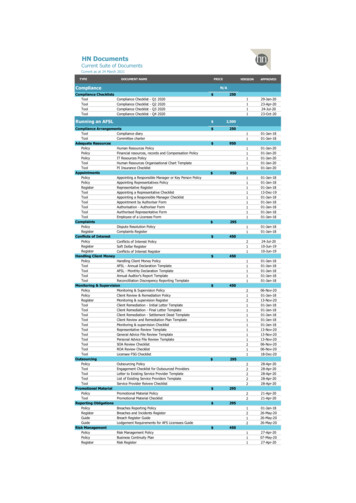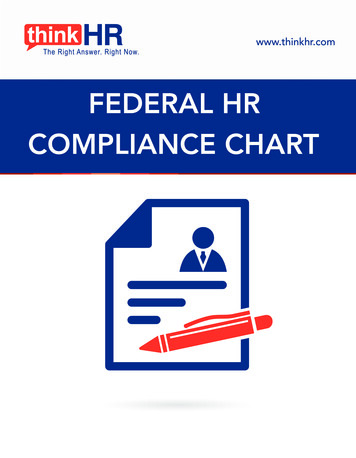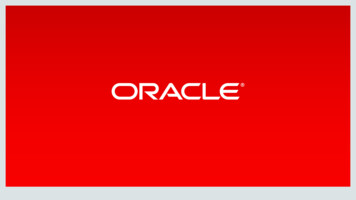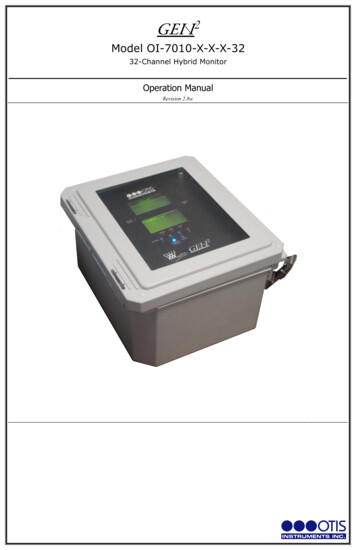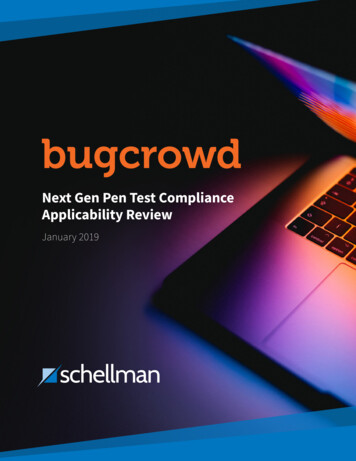
Transcription
Next Gen Pen Test ComplianceApplicability ReviewJanuary 2019
Statement Of ConfidentialityThe sole purpose of this document is to provide Bugcrowd, Inc. (Bugcrowd) with the results of Schellman’s reviewof their Next Generation Penetration Testing Service as it relates to the Payment Card Industry Data SecurityStandard (PCI DSS) and other regulatory and compliance requirements on penetration testing.This document, and any other Bugcrowd related information provided, shall remain the sole property ofBugcrowd and may not be copied, reproduced, or distributed without the prior written consent of Bugcrowd.ApplicabilityThe information found in this white paper and the conclusions reached were dependent upon the complete andaccurate disclosure of information by Bugcrowd.QSA Independence DisclosureSchellman & Company, LLC. (“Schellman”) reviewed certain aspects of the Next Generation Penetration TestingService for Bugcrowd from December 17, 2018, through January 11, 2019. During this time, Schellman did nothold any investment or control over Bugcrowd. During the course of this review, Schellman and the QSA did notmarket services for the purpose of assisting Bugcrowd in meeting any regulatory requirements pertaining to thepenetration testing services reviewed as part of this white paper. No Schellman service was recommended duringthe course of the engagement.Schellman also performed the SOC 2 type 1 and 2 and ISO 27001 examination for Bugcrowd concurrentlywith the assessment.2 Next Gen Pen Test Compliance Applicablity Review
SECTION 1:EXECUTIVE SUMMARYPurposeSchellman performed a review of Bugcrowd’s Crowdsourced Next Generation Penetration Testing (Next Gen PenTest) service for alignment with applicable penetration testing requirements of the PCI Data Security Standard,ISO:IEC 27001 Annex A, and NIST 800-53 revision 4. This assessment was completed in January 2019 by MattCrane, Senior Associate at Schellman & Company, LLC.ObjectiveThe objective of this assessment was to assist Bugcrowd in validating how the service enables its customers tomeet applicable compliance requirements for penetration testing. This assessment specifically targeted thefollowing areas: Standard agreements and instructions provided to customers Standard and customizable reports available to customers3 Next Gen Pen Test Compliance Applicablity Review
SECTION 1:EXECUTIVE SUMMARYCompany Background And Services ProvidedCompany BackgroundBugcrowd is a crowdsourced security platform primarily used for vulnerability identification through themanagement of vulnerability disclosure programs, bug bounties, and crowdsourced penetration testing services.Bugcrowd’s principle service offerings are fueled by a collective community of knowledge for the identificationand reporting of security vulnerabilities, which are validated, triaged, and prioritized by Bugcrowd. Bugcrowdadvocates that a community of researchers continuously testing an environment’s security features is significantlymore valuable than traditional penetration testing services. Bugcrowd provides its customers with access to acrowd of researchers without the management oversight needed by the customer to monitor.Next Gen Pen TestThe Bugcrowd Next Gen Pen Test service aims to satisfy requirements from auditors and reviewers with securitystandards in mind to meet various regulatory and compliance requirements. In a traditional crowdsourcedsecurity program, where a defined methodology is difficult to track in the reporting of the vulnerabilities, theincentivization for reporting vulnerabilities quickly can pose issues for companies attempting to comply withregulatory and compliance standards. Bugcrowd has addressed this issue with the introduction of Next GenPen Test. In this model, Bugcrowd layers the continuous bounty-incentivized testing of the crowd with thegrant-incentivized testing of dedicated pen testers and researchers following a defined methodology. Bugcrowdemployees then review, validate, and triage all findings, before combining into a compliance friendly reportingformat. This ensures a repeatable, defensible methodology is followed every time.Bug Bounty ProgramsBugcrowd offers a managed bug bounty service in which they are the mediator between their customers and acrowd of researchers. The bug bounty program allows organizations to have their environments or applicationstested by a large community of white hat hackers. Customers have the choice between a private bug bountyand a public bug bounty program. Private bug bounties are by invitation only and ensure all crowdsourcedresearchers involved have gone through a vetting process. Public bug bounties are available to the entireBugcrowd community of researchers and are promoted and publicized by Bugcrowd on their website.4 Next Gen Pen Test Compliance Applicablity Review
SECTION 1:EXECUTIVE SUMMARYSummary Of FindingsDuring the review of Bugcrowd’s Next Gen Pen Test, Schellman made the following observations that are furtherexplained throughout the rest of this white paper: Bugcrowd’s Next Gen Pen Test Service offering appears to directly assist organizations in meeting therequirements in PCI 6.6 for testing public facing web applications. The Next Gen Pen Test methodology directly supports organizations in achieving compliance with PCIrequirement 11.3 for internal and external penetration testing as long as the customer adequately defines thescope of their environment. The service offering provided has a limited capacity to meet PCI requirements for segmentation testing.This limitation can be overcome if customers take a few extra steps in defining segmentation controls, andreviewing the results of segmentation testing to determine if the segmentation controls were adequate. Schellman reviewed the Next Gen Pen Test methodology in collaboration with a sample report and notedthat the service offering directly supports NIST 800-53 rev4 CA-8 and ISO 27001 A.12.6.1 requirements forpenetration testing.Although the use of bug bounty programs can be useful inidentifying vulnerabilities and increasing an organizationsinformation security architecture, on their own they do not provideorganizations with much assistance in meeting regulatory andcompliance requirements.5 Next Gen Pen Test Compliance Applicablity Review
SECTION 2: PENETRATIONTESTING METHODOLOGYNext Generation Penetration Testing MethodologyAlignment with Industry StandardsSchellman observed Bugcrowd’s defined testing methodology and noted that it aligned with multiple industrystandards for technical testing to include NIST SP 800-115 and the OWASP Testing Guide v4. Review of anexample penetration testing report showed that alignment with the aforementioned industry standards wasconsistent and met various regularity and compliance requirements, such as the PCI DSS, NIST 800-53 rev4 andISO 27001. Further review of the methodology, in conjunction with PCI requirements 6.6 and 11.3, can be foundin section three of this white paper. Bugcrowd’s methodology for conducting Next Gen Pen Tests directly uses theOWASP Testing Guide v4 and its web application security testing steps. Schellman observed an example Next GenPen Test report and noted that each step was included in the testing practices.Service OptionsBugcrowd’s Next Gen Pen Test service offering includes two options for its customers to choose from; timebound testing and ongoing. Time bound testing is done in a manner where the customer chooses the start andend date for which Bugcrowd will conduct the Next Gen Pen Test. All activities conducted by Bugcrowd and itspool of crowdsourced researchers are completed during the period identified by the customer. Customers wereresponsible for ensuring that the time frame of the timebound Next Gen Pen Test was adequate to meet variousregulatory and compliance requirements.Ongoing testing is where customers allow continuous testing of their environments. This assessment typeprovides more coverage of a customer’s environment and allows Bugcrowd’s crowdsourced researchers toconduct continuous testing. Ongoing testing allows Bugcrowd’s pool of researchers continuous access to thecustomers environment. Constant testing allows customer environments to be tested after significant changes oras new vendor vulnerabilities are published. Furthermore, ongoing testing ensures that remediation activities canbe adequately retested by a Bugcrowd employee.6 Next Gen Pen Test Compliance Applicablity Review
SECTION 2: PENETRATIONTESTING METHODOLOGYTesting MethodologyThe methodology for performing a Next Gen Pen Test is split into four phases; reconnaissance, enumeration, proofof concept, and documentation. When reviewing common industry penetration testing standards, such as NISTSP 800-115, Bugcrowd identified similarities in the workflow of industry standards and used these similarities todevelop the methodology used in the Next Gen Pen Test. Schellman reviewed the defined testing methodologyand confirmed that the phases adequately followed the guidance provided by NIST SP 800-115 on performing aphased information security assessment.Each of the phases are executed in a cyclical manner allowing penetration testers to build upon findings andpotentially uncover significant risks. The reconnaissance phase begins with the customer providing informationregarding the scope of the Next Gen Pen Test. In this phase, customers will identify external URLs and IPaddresses to be tested, provide access to internal environments, and provide information regarding the networkarchitecture and segmentation controls. Additionally, the reconnaissance phase includes information gatheringby the community of researchers selected for the Next Gen Pen Test.The enumeration phase is where researchers identify attack vectors based on information gathered in thereconnaissance phase. Once a researcher has identified a vulnerability, they seek to verify the issue by creatinga proof of concept to prove the existence of the vulnerability. The researcher then reports the vulnerabilityto Bugcrowd in the documentation phase. Bugcrowd personnel will then confirm the vulnerability is alegitimate issue that has not already been reported. If the vulnerability is real and has not been reported inthe past, Bugcrowd will triage, prioritize, and attach remediation advice to the vulnerability before providingthe information to the customer. Customers can see all confirmed vulnerabilities in the vulnerability analyticsdashboard that they access through their account in Bugcrowd’s Crowdcontrol platform.Remediation TestingAs part of their Next Gen Pen Test service offering, Bugcrowd offers remediation testing to customers seeking toconfirm that a vulnerability previously identified was successfully fixed. Bugcrowd employees conduct the testand update the vulnerability analytics dashboard, as well as the report. In a standard ongoing Next Gen PenTest, there could be multiple instances in a given year where a confirmed vulnerability was remediated, and aBugcrowd employee performed testing to confirm that remediation was effective.7 Next Gen Pen Test Compliance Applicablity Review
SECTION 2: PENETRATIONTESTING METHODOLOGYCrowdsourced Researcher SelectionDuring the course of the engagement, Bugcrowd provided information regarding the selection and categorizationof researchers in their crowdsourced community. Schellman did not perform testing or a review of thiscategorization process, but felt it was pertinent to include in this report. Only researchers that had undergone abackground check and displayed an adequate level of skill were eligible to participate in Next Gen Pen Tests. Inaddition to requiring ID verification and background checks to meet various levels of trust, Bugcrowd uses thesetrust levels combined with a researcher’s demonstrated skill to identify an elite group, referred to as the “EliteCrowd.” These skilled penetration testers and white hat hackers are measured in two key areas: Skill and Trust.SKILLTRUSTA standard of highimpact submissions,averaging only high andcritical submissionsacross a range of specificattack surface areas.Proven trust throughID verification andsuccess working onprivate programs fortop customers.8 Next Gen Pen Test Compliance Applicablity Review
SECTION 3:COMPLIANCE REQUIREMENT COVERAGECompliance RequirementsResponsibilityCustomerNext GenPen TestAssessor FindingsPCI 6.6: For public-facing web applications, address new threats and vulnerabilities on an ongoing basis and ensure these applications are protected againstknown attacks by either of the following methods: Reviewing public-facing webapplications via manual orautomated application vulnerabilitysecurity assessment tools ormethods – as follows:Schellman observed Bugcrowd’s Next Gen Pen Test methodology along with a sample penetrationtest report and noted that it meets the requirements of a manual application vulnerability securityassessment. At least annuallyA customer’s use of a Next Gen Pen Test to meet this requirement on an annual basis is contingent uponthe following: Customers are responsible for ensuring all applicable public-facing web applications are identified andcommunicated to Bugcrowd If a customer selects a timebound test, the customer is responsible for ensuring the time frameidentified is adequate to allow for complete testing of the public-facing web application(s) in scope After any changesReview of an example Next Gen Pen Test indicated that Bugcrowd’s service offering directly supportstesting changes to public-facing web applications with the following caveats: Only changes made during the contracted testing window would be tested If a timebound Next Gen Pen Test is selected by the customer, only changes that are made during theidentified time frame will be tested By an organization that specializesin application securitySchellman interviewed the Chief Security Officer at Bugcrowd and noted that researchers selected for Next GenPen Test specialized in application security. Furthermore, Bugcrowd utilized a process for selecting researchersbased on skill* observed during previous private and public bug bounty programs.*Additional information regarding researcher skill determination can be found in Section 2 of this white paper.9 Next Gen Pen Test Compliance Applicablity Review
SECTION 3:COMPLIANCE REQUIREMENT COVERAGECompliance RequirementsResponsibilityCustomerNext GenPen TestAssessor Findings That, at a minimum, allvulnerabilities in Requirement 6.5are included in the assessmentSchellman reviewed Bugcrowd’s Next Gen Pen Test methodology and noted that application testingprocesses directly followed the OWASP Testing Guide v4, which includes testing of all vulnerabilitiesidentified in requirement 6.5. That all vulnerabilities are correctedBugcrowd customers are responsible for correcting all vulnerabilities identified. Bugcrowd providessome guidance for vulnerabilities identified during testing activities, but it is the customers responsibilityto ensure all vulnerabilities are corrected. That the application is re-evaluatedafter the corrections.Customers are responsible for notifying Bugcrowd that a vulnerability has been corrected. Bugcrowd willthen task employees, not the pool of crowdsourced researchers, to confirm that remediation activitiesconducted by the customer were effective.In the event that a customer has elected to use the timebound Next Gen Pen Test service, the customeris responsible for ensuring that the time frame of the test allows Bugcrowd the ability to conductremediation testing. Installing an automated technicalsolution that detects and preventsweb-based attacks (for example, aweb-application firewall) in front ofpublic-facing web applications, tocontinually check all traffic.10 Next Gen Pen Test Compliance Applicablity ReviewNot applicable. Customers using Bugcrowd’s Next Gen Pen Test service do not need to implement anautomated technical solution to meet PCI requirement 6.6.
SECTION 3:COMPLIANCE REQUIREMENT COVERAGECompliance RequirementsResponsibilityCustomerAssessor FindingsNext GenPen Test11.3: Implement a methodology for penetration testing that includes the following: Is based on industry-acceptedpenetration testing approaches (forexample, NIST SP 800-115)Schellman reviewed Bugcrowd’s Next Gen Pen Test methodology and noted that it aligned with NISTSP 800-115 and the OWASP Testing Guide v4. As recommended by NIST SP 800-115, the methodologyprovided to Schellman was repeatable, included the objective of the testing and contained processes fordefining and categorizing vulnerabilities. Bugcrowd’s Next Gen Pen Test methodology also included eachstep defined in the OWASP Testing Guide v4. Includes coverage for the entire CDEperimeter and critical systemsBugcrowd’s customers are responsible for defining the scope of the environment to be tested. Once thecustomer has confirmed the scope of the assessment, they are responsible for providing this informationto Bugcrowd and ensuring it includes the entire perimeter of the environment and all critical systems.In regard to internal penetration testing, Bugcrowd’s Next Gen Pen Test can only cover systems andenvironments that the customer identifies and provides access to. Includes testing from both insideand outside the networkBugcrowd’s Next Gen Pen Test has the capacity to test various aspects of a customer’s environmentfrom both inside and outside of the network. It is the customer’s responsibility to ensure Bugcrowd’sresearchers have access to systems inside the network if the customer desires internal testing to becompleted. The customer is also responsible for granting access to internal network segments.11 Next Gen Pen Test Compliance Applicablity Review
SECTION 3:COMPLIANCE REQUIREMENT COVERAGECompliance RequirementsResponsibilityCustomer Includes testing to validate anysegmentation and scope-reductioncontrolsNext GenPen TestAssessor FindingsCustomers are responsible for defining and determining the appropriateness of segmentation controls intheir environments. Bugcrowd’s Next Gen Pen Test has the capacity to assist in meeting PCI requirementsfor segmentation testing as long as the customer does the following: Customers must request segmentation testing Customers are responsible for defining segmentation controls and interpreting the results of thesegmentation test to determine if segmentation controls implemented by the customer are operationaland effective Customers must include all segmentation controls/methods in the information provided to Bugcrowdin order to ensure all controls/methods are tested Defines application-layerpenetration tests to include, at aminimum, the vulnerabilities listedin Requirement 6.5Schellman observed Bugcrowd’s Next Gen Pen Test methodology and noted that application testingprocesses directly followed the OWASP Testing Guide v4, which includes testing of all vulnerabilitiesidentified in requirement 6.5. Defines network-layer penetrationtests to include components thatsupport network functions as wellas operating systemsObservation of example penetration tests conducted under the Next Gen Pen Test methodology indicatethat customers are responsible for defining network-layer penetration tests. Through interviews withthe Chief Security Officer at Bugcrowd, Schellman noted that Bugcrowd had the capacity to conductnetwork-layer penetration testing, but customers were responsible for defining and identifyingcomponents that support network functions, and customers must request network-layer penetrationtesting as part of their ongoing or timebound Next Gen Pen Test.Note: Schellman reviewed an example internal network penetration test conducted in 2016 that wasperformed as part of a different service offering prior to the development and offering of Next Gen PenTest. It is reasonable to assume that Bugcrowd personnel have the capacity to perform network-layerpenetration testing, but Schellman was unable to validate this as part of this assessment.12 Next Gen Pen Test Compliance Applicablity Review
SECTION 3:COMPLIANCE REQUIREMENT COVERAGECompliance RequirementsResponsibilityCustomer Includes review and considerationof threats and vulnerabilitiesexperienced in the last 12 monthsNext GenPen TestAssessor FindingsAs part of Bugcrowd’s broader vulnerability management service offerings, Bugcrowd offers customersaccess to a Crowdcontrol platform that contains a vulnerability analytics dashboard. Customerssubscribing to the Next Gen Pen Test service offering have access to these services for viewingvulnerability information. Schellman observed an example of the vulnerability analytics dashboard andnoted that it was designed to retain vulnerability information for the duration of a customer’s relationshipwith Bugcrowd.Customers are responsible for retaining formal penetration test reports and findings delivered to them atthe end of both timebound and ongoing Next Gen Pen Tests. Customers are also responsible for retainingrecords of any and all vulnerabilities identified prior to the start of services from Bugcrowd. Further,customers are responsible for maintaining a vulnerability management policy in conjunction with PCIrequirement 6.1. Specifies retention of penetrationtesting results and remediationactivities results.Schellman observed Bugcrowd’s penetration testing methodology and noted that retention of testingresults would occur for the duration of the contracted relationship between Bugcrowd and theircustomers. Customers have a shared responsibility to maintain formal testing results as part of theirapplicable data retention and vulnerability management policies.Customers electing to use the timebound Next Gen Pen Test service offering are responsible for retainingall testing results after the defined period has concluded with Bugcrowd.Although Bugcrowd retains information regarding the vulnerabilities and results of testing, the customeris ultimately responsible for retaining formal reports for the purposes of meeting regulatory requirementsto include the PCI-DSS.13 Next Gen Pen Test Compliance Applicablity Review
SECTION 3:COMPLIANCE REQUIREMENT COVERAGECompliance RequirementsResponsibilityCustomerNext GenPen TestAssessor Findings11.3.1: Perform external penetration testing at least annually and after any significant infrastructure or application upgrade or modification (such as anoperating system upgrade, a sub-network added to the environment, or a web server added to the environment).PCI 11.3.1.a Examine the scope of workand results from the most recent externalpenetration test to verify that penetrationtesting is performed as follows: Per the defined methodology At least annually After any significant changes to theenvironment.Schellman observed program details and an example penetration testing report under Bugcrowd’s NextGen Pen Test service offering and noted the following: Customers are responsible for defining the scope of external penetration tests Observation of the example penetration test shared with Schellman indicated the definedmethodology was followed Use of the Ongoing Next Gen Pen Test provides direct support of conducting external penetrationtesting on an annual basis with a formal report being delivered at an agreed upon date. The Ongoing Next Gen Pen Test allows for continuous testing of customer environments to includeafter significant changes. Depending on the nature of a change, Customers will likely need to notifyBugcrowd to ensure ongoing testing includes checks for additional security issues introduced by thechange to the customers environment.Customers electing a Timebound Next Gen Pen Test will need to ensure the duration of time is adequateto address significant changes and that a timebound penetration test is conducted at least annually.PCI 11.3.1.b Verify that the test wasperformed by a qualified internalresource or qualified external thirdparty and, if applicable, organizationalindependence of the tester exists (notrequired to be a QSA or ASV).14 Next Gen Pen Test Compliance Applicablity ReviewSchellman interviewed the Chief Security Officer at Bugcrowd and noted that researchers selectedfor Next Gen Pen Test were qualified to conduct external penetration tests. Furthermore, Bugcrowdutilized a process for selecting researchers based on skill. Additional information regarding researcherskill determination can be found in section 2 of this white paper. Finally, Bugcrowd’s Crowdsourcedresearchers were neither involved in remediation activities nor were they involved in remediation testing,thus indicating organizational independence.
SECTION 3:COMPLIANCE REQUIREMENT COVERAGECompliance RequirementsResponsibilityCustomerNext GenPen TestAssessor FindingsPCI 11.3.2 Perform internal penetration testing at least annually and after any significant infrastructure or application upgrade or modification (such as anoperating system upgrade, a sub-network added to the environment, or a web server added to the environment).PCI 11.3.2.a Examine the scope of workand results from the most recent internalpenetration test to verify that penetrationtesting is performed as follows. Per the defined methodology At least annually After any significant changes to theenvironment.Schellman observed program details and an example penetration test report under a predecessor of theNext Gen Pen Test service offering* and noted the following: Customers are responsible for defining the scope of internal penetration tests Observation of the example penetration test shared with Schellman indicated the definedmethodology was followed Use of the Ongoing testing service offering provides direct support of conducting internal penetrationtesting on an annual basis with a formal report being delivered at an agreed upon date. The Ongoing Next Gen Pen Test allows for continuous testing of customer environments to includeafter significant changes. Depending on the nature of a change, customers will likely need to notifyBugcrowd to ensure ongoing testing includes checks for additional security issues introduced by thechange to the customers environment.Customers choosing to conduct a Timebound Next Gen Pen Test will need to ensure the duration of time isadequate to address significant changes and that a timebound penetration test is conducted at least annually.*Schellman reviewed an example internal network penetration test conducted in 2016 that wasperformed as part of a different service offering prior to the development of the Next Gen Pen Test. It isreasonable to assume that Bugcrowd personnel have the capacity to perform network-layer penetrationtesting, but Schellman was unable to validate this as part of this assessment.15 Next Gen Pen Test Compliance Applicablity Review
SECTION 3:COMPLIANCE REQUIREMENT COVERAGECompliance RequirementsResponsibilityCustomerPCI 11.3.2.b Verify that the test wasperformed by a qualified internalresource or qualified external thirdparty and, if applicable, organizationalindependence of the tester exists (notrequired to be a QSA or ASV).Next GenPen TestAssessor FindingsSchellman interviewed the Chief Security Officer at Bugcrowd and noted that researchers selectedfor Next Gen Pen Test were qualified to conduct internal penetration tests. Further, Bugcrowd utilizeda process for selecting researchers based on skill. Additional information regarding researcher skilldetermination can be found in section 2 of this white paper. Finally, Bugcrowd’s Crowdsourcedresearchers were not involved in remediation activities nor were they involved in remediation testing,thus indicating organizational independence.PCI 11.3.3: Exploitable vulnerabilities found during penetration testing are corrected and testing is repeated to verify the corrections.PCI 11.3.3 Examine penetration testingresults to verify that noted exploitablevulnerabilities were corrected andthat repeated testing confirmed thevulnerability was corrected.Because customers are responsible for all remediation activities, customers also share the responsibilityfor the re-evaluation of all corrected vulnerabilities. Customers are responsible for notifying Bugcrowd thatan exploitable vulnerability previously identified by Bugcrowd has been remediated. Bugcrowd will thenuse Bugcrowd employees, not the pool of crowdsourced researchers, to confirm that remediation activitiesconducted by the customer were effective. In the event that a customer has elected to use the timeboundNext Gen Pen Test service, the customer is responsible for ensuring that the period identified allowsBugcrowd the ability to conduct remediation testing.PCI 11.3.4 If segmentation is used to isolate the CDE from other networks, perform penetration tests at least annually and after any changes to segmentationcontrols/methods to verify that the segmentation methods are operational and effective, and isolate all out-of-scope systems from systems in the CDE.PCI 11.3.4.a Examine segmentationcontrols and review penetration-testingmethodology to verify that penetrationtesting procedures are defined to testall segmentation methods to confirmthey are operational and effective, andisolate all out-of-scope systems fromsystems in the CDE.16 Next Gen Pen Test Compliance Applicablity ReviewCustomers are responsible for defining and determining the appropriateness of segmentation controls intheir environments. Bugcrowd’s Next Gen Pen Test has the capacity to assist in meeting PCI requirementsfor segmentation testing as long as the customer does the following: Customers must request segmentation testing
SECTION 3:COMPLIANCE REQUIREMENT COVERAGECompliance RequirementsResponsibilityCustomerNext GenPen TestAssessor FindingsPCI 11.3.4.b Examine the results from themost recent penetration test to verify that:Customers are responsible for defining segmentation controls and interpreting the results of
Feb 12, 2019 · OWASP Testing Guide v4 and its web application security testing steps. Schellman observed an example Next Gen Pen Test report and noted that each step was included in the testing practices. Service Options Bugcrowd’s Next Gen Pen Test service offering includes two options for its customers to choo
